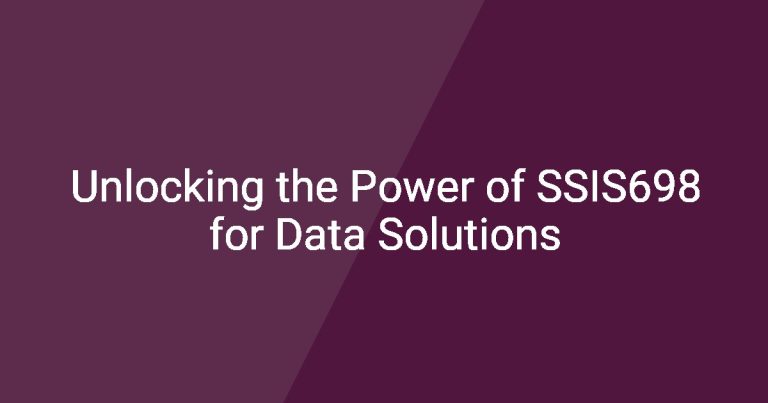SSIS469 is an essential tool in the realm of data management and integration, particularly for organizations relying on SQL Server Integration Services (SSIS). Understanding SSIS469 is crucial for tackling the multifaceted challenges of data integration, facilitating smoother operations for businesses striving to manage their data effectively.
Introduction to SSIS469
Definition of SSIS469
SSIS469, short for SQL Server Integration Services 469, represents a specific version of Microsoft’s data integration and ETL (Extract, Transform, Load) tool within the SQL Server suite. This version brings a range of enhancements focusing on improving data handling and transformation capabilities crucial for organizations dealing with vast amounts of data.
The importance of SSIS469 lies not only in its capabilities but also in its role as a bridge facilitating smoother interactions between disparate data sources and systems. By leveraging SSIS469, businesses can ensure that their data integration processes are both efficient and reliable, ultimately leading to better decision-making and operational efficiency.
Relevance in Data Integration
In today’s data-driven world, organizations face numerous challenges related to data integration. These challenges often stem from working with multiple data sources, including databases, file systems, and cloud services. SSIS469 plays a pivotal role in overcoming these hurdles by offering robust solutions for data aggregation, transformation, and migration.
SSIS469 provides users with the tools necessary for establishing reliable data workflows. It enables users to consolidate data from various sources, ensuring that the data is not only accurate and consistent but also readily available for analysis. This capability is integral for businesses that rely on timely insights to tailor their strategies and operations effectively.
Overview of SQL Server Integration Services (SSIS)
What is SQL Server Integration Services?
SQL Server Integration Services (SSIS) is a powerful data integration and workflow service designed primarily for data migration and transformation processes. Within the SSIS framework, users can create packages that define data movement and transformation steps, allowing for automation across various data infrastructures.
The architecture of SSIS consists of several key components, including Data Flow, Control Flow, and Event Handlers, each serving distinct functions. Data Flow is responsible for the actual movement of data from source to destination, while Control Flow manages the sequence of tasks to be executed within the SSIS package. This modular design increases flexibility and scalability in managing data.
Importance of SSIS in Data Management
The significance of SSIS in modern data management cannot be overstated. It plays a critical role in the ETL process, essential for preparing data for analysis and reporting. SSIS allows organizations to automate complex data workflows seamlessly, reducing the time and effort required for data handling.
Furthermore, SSIS ensures that data quality and integrity are maintained throughout the data lifecycle. By incorporating various validation and cleansing transformations, businesses can trust the data they work with, which is vital for making informed decisions.
Key Features of SSIS469
Enhanced Data Processing Capabilities
One of the standout features of SSIS469 is its enhanced data processing capabilities. This version significantly increases performance when handling large datasets, allowing businesses to process and analyze data faster than ever before.
SSIS469 supports complex transformations, which are essential for modifying and cleaning data in preparation for analysis. Advanced functionalities enable users to implement intricate logic without compromising on speed or performance.
Integration with Other Systems
SSIS469 offers compatibility with a range of cloud services and tools, ensuring that organizations can integrate their data seamlessly across various platforms. Whether it’s integrating data from Microsoft Azure, Salesforce, or other cloud applications, SSIS469 provides the interoperability needed to create a cohesive data ecosystem.
Additionally, this version is designed to work harmoniously with various database technologies, allowing for simplified data management across systems. Organizations benefit immensely from this flexibility, as it reduces the complexity of managing different data sources.
User-Friendly Interface
The user-friendly interface of SSIS469 makes it accessible for both developers and business analysts alike. The workflow design capabilities empower users to create and deploy packages with ease, even without extensive technical knowledge.
The SSIS Designer tool further enhances the ease of creating data workflows, providing a drag-and-drop interface that simplifies the design process. This user-centric approach reduces the learning curve and enables teams to collaborate effectively on data projects.
Implementation of SSIS469
System Requirements
To implement SSIS469 effectively, organizations must adhere to specific system requirements. The hardware and software prerequisites include a compatible SQL Server version, adequate RAM, processor speed, and sufficient disk space.
Organizations should aim to run SSIS469 on robust platforms capable of handling large-scale data processing tasks to ensure optimal performance.
Step-by-Step Installation Guide
Installing SSIS469 involves several steps:
1. **Downloading SSIS469**: Obtain the installation package from the Microsoft website or respective vendor.
2. **Installation Process Overview**: Launch the installer and follow the guided prompts to complete the installation. Ensure all components are selected as needed.
3. **Configuring SSIS for First-Time Use**: After installation, run the SSIS Configuration Manager to set up the data sources and connections.
These steps help organizations leverage the power of SSIS469 from the outset.
Best Practices for Implementation
To maximize the benefits of SSIS469 implementation, businesses should follow best practices, including:
– **Project Planning and Design Considerations**: Adequately plan for resource allocation, timeline, and design elements before starting the project.
– **Minimizing Risks During Deployment**: Use staging environments to test packages before going live to identify potential issues.
– **Testing and Validation Techniques**: Implement rigorous testing methods to ensure data accuracy and package performance.
By adhering to these practices, organizations can reduce implementation risks and enhance overall productivity.
Working with SSIS469
Creating Packages
At the core of SSIS469 are packages that encapsulate the data workflows. An SSIS package comprises various components such as connections, tasks, and data flows.
Using the SSIS Designer, users can create packages visually, laying out workflows that dictate how data is processed and moved. This intuitive approach allows for quick adjustments and modifications as business needs evolve.
Data Flow Tasks and Transformations
Data flow tasks are crucial in SSIS469, as they determine how data is extracted from sources, transformed, and loaded into destinations. SSIS469 provides an array of common transformations that users can leverage, including:
– Data conversion
– Lookup functions
– Aggregations
These transformations enable users to tailor their data processing needs to specific requirements, enhancing the overall utility of their data integration efforts.
Error Handling and Logging
Managing errors effectively is vital in data integration projects. SSIS469 offers various strategies for error handling, including retry mechanisms and notifications.
Additionally, setting up logging within SSIS469 allows for streamlined debugging and monitoring of ETL processes. Users can configure logs to capture detailed execution information, ensuring they can promptly address any issues that arise.
Advanced Features of SSIS469
Custom Components and Scripts
For businesses looking for customized solutions, SSIS469 supports creating custom components and transformations. Developers can design specific logic through scripting components, allowing for flexible data handling tailored to unique business needs.
This capability extends SSIS469’s functionality, enabling users to implement specialized processes that standard out-of-the-box components may not cover.
Performance Optimization Techniques
To enhance the performance of SSIS469 packages, organizations can adopt various optimization techniques. These can include:
– Efficiently utilizing memory and CPU resources during data processing.
– Implementing parallel processing for tasks and data flows to maximize throughput.
– Using appropriate caching strategies to minimize database hits.
These best practices help ensure that SSIS469 remains an effective tool even as data volumes and complexity increase.
Case Studies and Real-World Applications
Use Case Analysis
Numerous industries and organizations have successfully leveraged SSIS469. For instance, a financial institution used SSIS469 to integrate real-time transaction data from multiple sources, enhancing their data analytics capabilities significantly.
Another case involves a retail chain that utilized SSIS469 to streamline its inventory data across various platforms, including cloud storage and on-premise databases, resulting in improved inventory management and reporting.
Lessons Learned from Implementations
While implementing SSIS469 offers substantial benefits, several common challenges have been encountered. Issues like data quality, integration with legacy systems, and performance tuning are often faced during deployment.
Learning from past implementations, organizations have been able to mitigate these challenges by investing in comprehensive training for the development team and conducting thorough testing before deployment.
Conclusion
Summary of the Benefits of SSIS469
SSIS469 offers an impressive suite of features and enhancements that significantly improve data integration processes. From user-friendly design capabilities to advanced data processing techniques, it empowers organizations to handle their data more efficiently.
The Future of SSIS469 in Data Integration
As data continuously evolves, so too will the tools required to manage it. The future of SSIS469 appears promising, with potential developments likely focusing on more extensive cloud integration, improved machine learning capabilities, and enhanced user experience. Organizations that incorporate SSIS469 will be well-positioned to adapt to the changing data landscape.
References
Additional Reading and Resources
– [Microsoft SQL Server Integration Services Documentation](https://learn.microsoft.com/sql/integration-services/sql-server-integration-services)
– [SQL Server Data Integration Tutorial](https://www.sqlshack.com/sql-server-integration-services-ssis-tutorial/)
| Feature | Description | Benefit |
|---|---|---|
| Enhanced Data Processing | Improved performance for large datasets | Faster data handling and analysis |
| Cloud Integration | Compatibility with cloud services | Seamless data access across platforms |
| User-Friendly Interface | Intuitive package creation tools | Lower learning curve for users |
| Custom Components | Ability to build tailored transformations | Flexible data handling for unique needs |
FAQ
1. What is SSIS469 used for?
SSIS469 is primarily used for data integration, transformation, and migration within SQL Server environments.
2. What are the key features of SSIS469?
Key features include enhanced data processing capabilities, cloud integration, a user-friendly interface, and support for custom components.
3. How can I install SSIS469?
You can install SSIS469 by downloading the installer from Microsoft, then following the guided installation process and configuring the setup.
4. What are the system requirements for SSIS469?
The system requirements include a compatible SQL Server version, sufficient RAM, CPU performance, and adequate disk space.
5. Can SSIS469 work with cloud services?
Yes, SSIS469 is designed to integrate seamlessly with various cloud services, making it easier to manage and move data across platforms.
6. How does SSIS469 ensure data quality?
SSIS469 supports various validation and cleansing transformations to maintain data quality throughout the ETL process.
7. What is the role of the SSIS Designer?
The SSIS Designer allows users to create and manage workflows visually, simplifying the package creation process.
8. Can I create custom transformations in SSIS469?
Yes, SSIS469 supports custom components, allowing developers to create tailored transformations suited to specific business needs.
9. How do you handle errors in SSIS469?
SSIS469 provides mechanisms for error handling, including retry strategies and log configurations to troubleshoot issues.
10. What are the best practices for implementing SSIS469?
Best practices include careful project planning, thorough testing, and leveraging staging environments to minimize deployment risks.







